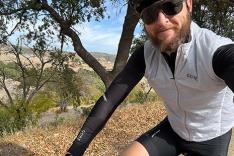The following is a list of popular movements or techniques that should be avoided at all costs in any indoor cycling class, whether the rider is a cyclist or not. If your instructor does any of these, simply smile and ride your bike like you're supposed to ride a bike. On the other hand, if the instructor insists the class do any of these, then run, don't walk, towards the nearest door.
I provide a short reason why these are contraindicated, but the detailed physiological, biomechanical, exercise science and cycling explanations can be found in the eBook Keep it Real.
Lifting Weights or Using Bands While Riding
These two training modalities should not be combined. Since you cannot lift the amount of weight that would increase your muscle fiber strength, it is a total waste of time from the weight lifting standpoint and it detracts substantially from your ability to pedal properly. Therefore, neither modality does you any good, and the effectiveness of each are negated. Go to the weight room after class if you want stronger pecs or delts. Unfortunately, adding weight workouts to pedaling has become all the rage lately, as studios try to combine upper body workouts with cardio. Just don't do it!
Pushups
If you are sitting at a desk reading this, put your hands on the desk or table infront of you and do a couple of so-called pushups. Need I say more? They do nothing for you pecs and everything to inhibit your pedaling and proper breathing. You can include any kind of upper-body contrived movement in this category, such as twisting or turning or bobbing and weaving.
Crunches
Similar to pushups, they are not effective when sitting upright. The instructor does not know his exercise physiology if he's teaching these. Cyclists do need to work their core, but do so in a pilates or fitball class and not on the bike.
Hovers
Very, very popular. Instructors claim hovers mimic mountain biking and that they work the glutes and hamstrings. In reality, all they do is put your knees, hips and back at risk, because the butt is pushed way back over the saddle, hyperextending the low back, while you are pedaling at 70-90 times a minute. Biomechanically the knee joint is at an unsound angle to apply effective force to the pedal.
Besides, on a mountain bike, when you push the hips back and lower the shoulders, it is because you are going downhill steeply and you don't want fly over the bars. You are also maneuvering the bike underneath you, and you are not pedaling while you do it.
Isolations
Instructors like to turn indoor cycling classes into a core workout by having you hold completely still and suck in the abs. They might ask for you to "isolate" the hips while pedaling. The quads and glutes will soon start burning, but do not interpret that as an effective burn. There is nothing functional about this movement—the burn is from mechanical inefficiency. You won't become more fit by doing this, and your core will not become stronger, but you will look silly and like all the rest, your ability to maintain a consistent pedal stroke is inhibited.
Squats, or Lowering the Hips
Potentially one of the most dangerous of the popular moves. One can only imagine the increased forces in the knee joint as the hips are lowered, and as the pedal drives the tibia upwards into the femur at an odd angle 80 or 90 times a minute. Think improper squats in the weight room driving the knees forward of the toes—at super high speeds.
Proponents love to praise the burn in the quads, but similar to isolations, that burn is due to mechanical inefficiency, not any kind of functional strength building in the muscle. Get out of there fast if your instructor does these.
Excessive High Cadence With No Resistance
Part of the power equation is to have a force against which to push. If there is no (or too low) resistance, then power drops, even if cadence is high. When power is reduced, work is decreased, and so is fitness potential and calories burned. Instead of pedaling like a hamster on crack, bobbing in the saddle at 120-plus rpm, it's far better to turn up the resistance and lower the cadence—preferably below 100 rpm. Do this and your power will increase—a goal of all cyclists, indoors and outdoors.
- 2
- of
- 4








Discuss This Article